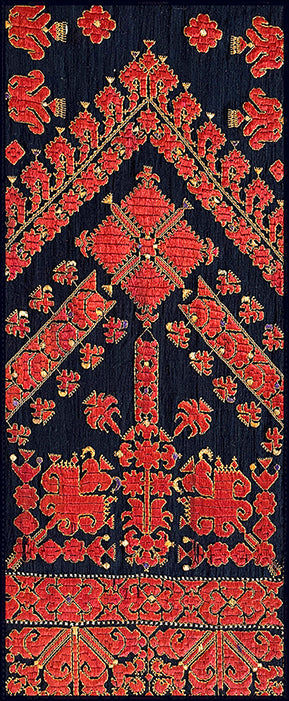Your Cart is Empty
1641 SOLD Large Gujarat Ceremonial Cloth with a Row of Female Musicians
Sold to a discerning Antique Art-Lover
***
Large complete panel depicting a procession of women musicians with their musical instrument (most likely the Tanpura).
Block printed with a fabulous teal & red print on a beige background. Double-sided - so when flipped over we see the same depiction with the women facing the other direction. Not easy to make out which is the correct side of the cloth.
All old examples of a similar type have been described as trade cloths traded out of Gujarat to Toraja.
MY NOTES ON 1641
The character of the women is similar to those seen in the various arts of Gujarat.
Firstly, Jain paintings usually show the side-face or the profile in a unique way - the eye that is not seen is depicted as a protruding element. This feature is seen in this painting.
Secondly, the crown is typical of Radha Rani but the musical instrument suggests Mirabai, both associated with Krishna - the most popular god among Hindus in Gujarat.
The yarn appears to be hand-spun with slubs and uneven character. [See last two photos]
This textile is similar to the 'Ceremonial Cloth and Heirloom Textile with Row of Female Musicians' at the LACMA.
Wovensouls Asset 1641 has the following unique features to suggest that it is neither a reproduction nor a copy.
a) the detail in the earrings of the women: In the wovensouls cloth, there appears to be a swan / peacock (rotated to be facing upwards) and a fish, whereas in the LACMA one there is a swan / peacock upright.
b) the pointed curved toe-ring in our textile is very different from the one at LACMA.
c) The rounded cheeks, lips, chin, double-chin and eyes are well-defined and beautiful whereas the features of the same in the LACMA cloth are overshadowed by the background.
d) The hair ornaments worn by the women on the wovensouls cloth is well-developed and beautiful compared to the others
e) The LACMA textile has more micro-details in the petals of the flowers on the skirt. The details on the tanpura are beautiful on the LACMA textile whereas on 1641 they are not well-developed.
The LACMA textile is stated to be over 3 centuries old but 1641 is estimated to be much younger from the 1900s.
As 1641 is a block printed cloth, these unique features do not come about simply upon creative 'in-the-moment' whims - the block would have to be created with deliberation according to a plan. Had it been a copy, there would have been an attempt to increase the likeness rather than a deliberate attempt to develop its own identity.
Assuming that these are ceremonial cloths, there should be ceremonies associated with these cloths. And ceremonies that are followed by a community would have been practiced over generations and the practice would span decades. And therefore, the supporting materials - such as these textiles - would continue to be in demand and continue to be produced - not just five of six times in the history of mankind, but dozens of times if not hundreds of times over decades and centuries.
And so, my conclusion is that 1641 is a younger remnant of the ceremonial traditions.
While literature calls these 'ceremonial' textiles, there is no further elaboration on the ceremony.
As long as the community continues it's traditional ceremonies, even after allowances fro minor variations in method & materials, the overall construct would remain intact. And so such cloths should be seen either in use or in museums or in memory especially in well-preserved cultures.
Now the common understanding is that this group of textiles is from Toraja.
In my initial interviews with local people in Toraja, there is no obvious recognition of this type of cloth. Secondly it is radically different from other textiles of Toraja.
And so the original notes written by textile lovers and travelers in the pastleave me with unanswered questions.
This is the subject of my next exploratory research project in Toraja.
In the meanwhile the details of 1641 are:
Age: Estimated to be from the early-mid 1900s
Size: 188 x 35 inches = 477 x 91 cm
Condition: Fair - part of a border missing, a few holes, tears etc.
.
Like it? Share it with friends on Facebook!
.......................................................................................................................



































































































